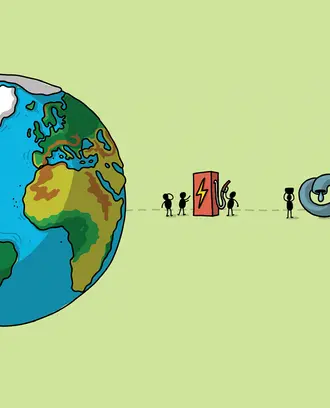Credit: sixpixx / Shutterstock
‘Climate Future’: What to do if reducing emissions isn’t enough?
Climate change discussions typically focus on how to reduce greenhouse gas emissions. But are emission-reduction scenarios realistic, and can they prevent substantial warming? Moreover, what happens if temperatures and sea levels climb despite these efforts?
an MIT Sloan professor of finance and economics, believes that reducing emissions is an important goal. He also thinks it’s impossible to predict how much it can help.
Pindyck, an environmental economist whose recent work focuses on climate change, is a critic of relying on forecasting models to shape policy. He stresses that there is considerable uncertainty over how much climate change we can expect, and what its impact will be on the economy.
In his latest book, Climate Future: Averting and Adapting to Climate Change, released this month, Pindyck asserts that counting on a best-case emissions scenario isn’t effective policy. He posits that global warming might persist despite mitigation efforts. As he has pointed out, even if the United States and Europe — which currently account for 30% of global CO2 emissions — were to reduce their emissions next week to zero (an unlikely scenario), that would still leave 70% of emissions unaccounted for.
Instead, the book offers actionable solutions for adaptation, such as geoengineering and developing new hybrid crops.
“Reducing emissions is not enough; to ensure against a catastrophic climate change outcome we need to invest now in adaptation,” he writes.
In the following excerpt from the preface to “Climate Future,” Pindyck lays out the argument that climate change policy needs to balance emissions reduction with more realistic, immediate approaches.
++++++
Current debates over climate change policy are focused almost entirely on how to reduce emissions.
Reducing emissions — via a carbon tax, emission quotas, adoption of “green” energy technologies, or other means — is an important goal, and should continue to be a fundamental part of climate policy. It should also be a subject of environmental policy research; we need to learn more about how to reduce emissions, and what are the advantages and disadvantages of alternative approaches to reducing emissions.
Related Articles
Reducing emissions is clearly something we should do. But we also need to answer the following question: What will we do? Yes, in all likelihood we will reduce emissions of CO2 and other greenhouse gases, but by how much and how fast? Enough to prevent a temperature increase greater than 1.5 or 2.0°C by the end of the century?
What if, despite our best efforts, we are simply unable to reduce emissions enough to prevent a temperature increase of 2°C or more? What then? Do we just wave our hands and say “Too bad”? And if today we think that there is a strong possibility that (despite our best efforts) we are likely to experience a temperature increase greater than 2°C, what should we do?
I argue in this book that given the political and economic realities, it is extremely unlikely that the world will even come close to meeting current targets for CO2 emission reductions. Some countries (e.g., the U.S. and Europe) may meet their targets, but other countries (China, India, Indonesia, Russia ... ) will not, and may not even set targets. In fact, even the most optimistic projections of CO2 emission reductions imply a substantial buildup of CO2 in the atmosphere, and as a result a gradual increase in temperatures worldwide.
I explain some of the basics of climate change in this book, with an emphasis on what we know and don’t know about the extent of climate change that might occur, and the impact of climate change on the economy and on society more generally. Despite decades of research, there is still a great deal that we don’t know about climate change, and perhaps most important, about the impact that higher temperatures and rising sea levels might have.
Put simply, whatever climate policies are adopted, there will be a great deal of uncertainty over what will happen as a result. I explain why there is so much uncertainty, and what it implies for the design of policy.
I show that for any realistic scenario for CO2 emission reductions, there is a strong likelihood of a global mean temperature increase over the next 50 years that could turn out to be 3°C or even higher.
Higher temperatures could lead to rising sea levels, greater variability of weather, more intense storms, and other forms of climate change.
What will be the impact of those changes? How will it affect economic output and other measures of social welfare, such as mortality and morbidity? Again, we don’t know.
But the fact that we don’t know doesn’t mean we should be complacent. The outcome could be catastrophic, especially if society is unprepared for it. What does this reality imply for climate policy?
I argue that partly because there is so much uncertainty, we need to do more to reduce emissions.
But reducing emissions is not enough; to ensure against a catastrophic climate change outcome we need to invest now in adaptation. Adaptation can have many forms — developing new hybrid crops, adopting policies to discourage building in flood-prone or wildfire-prone areas, building sea walls and dikes, and forms of geoengineering are examples.
Developing new ways to abate emissions remains important, but climate change research, and climate change policy, should put more emphasis on adaptation than it has in the past.
Excerpted from "Climate Future: Averting and Adapting to Climate Change" by Robert S. Pindyck. Copyright © 2022 by Robert S. Pindyck. Published by Oxford University Press. All Rights Reserved.



